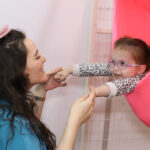Brachial Plexus Rehabilitation
BRACIAL PLEXUS INJURY
The nerve roots originating from the spinal cord in the neck region, traveling as 3 large branches, join in the armpit space and form a large nerve network. Brachial plexus injury occurs as a result of the lesions of the nerve network in this region.
Nerves from the Brachial Plexus to the arm exit from the spinal cord. This neural network includes 4 large cervical (neck) nerve roots (C5-C8) and first dorsal (thoracic) nerve root (T1). These roots unite and divide into 3 main branches. The branches from the C5-C6 roots form the upper branches, the branches from the C7 roots form the middle, and the branches from the C8-T1 roots form the lower large branches.
Each major branch is divided into sections and moves the muscles (flexors), some of which generally bend the arm and raise it up (flexor), and other parts to the muscles that extend the arm and lower it (extensor).
What is Brachial Plexus Injury?
Brachial Plexus injury is the development of paralysis at varying degrees in the arm muscles stimulated by this nerve as a result of damage to the nerve network (Brachial Plexus) that goes from the brain to the arm through the spinal cord. Although it varies according to the affected nerve roots, paralysis starting from the arm muscles can reach the fingers of the hand.
What Causes Brachial Plexus Injury?
Paralysis that develops in varying degrees as a result of the Brachial Plexus injury, is a condition that starts in the neonatal period and continues throughout childhood, and requires long-term follow-up and rehabilitation. Most of these injuries occur during birth. However, Brachial Plexus injury has also been reported in deliveries by cesarean section. Mostly;
- High birth weight (especially over 4 kg)
- Difficult and prolonged birth,
- Use of auxiliary tools such as vacuum and forceps during birth,
- Shoulder or breech presentation,
- And many other reasons such as structural strictures in the mother are blamed for Brachial Plexus injuries.
- Traumas in the nerves;
- Avulsion type (ruptured from the peripheral synoromuric)
- In the form of neuropraxia (edema around the nerve) or
- Axonotmesis (nerve sheath is normal, only axon damage is present).
Nerve rupture is irreversible. Regeneration is possible in other types of injuries.
What are the Symptoms of Brachial Plexus Injury?
Since the Brachial Plexus takes nerve fibers from the roots between C5 and T1, the paralysis that will occur will vary according to the level of the nerve involved. Although it is generally examined under three headings, it can show transition to each other.
- Upper trunk (nerve root) involvement is called Erb-Duchenne type paralysis and it is the most common type. Babies with this type of injury cannot move their shoulders and have difficulty extending and rotating their arms. If C7 involvement occurs, fingers curl in the position of asking for tips. If C4 involvement takes part, the phrenic nerve is affected and related symptoms also occur.
- Lower trunk (nerve root) involvement is called Klumpke’s palsy. Isolated lower trunk injury is rare. Arm, shoulder and elbow movements are good in classical condition. However, hand claw deformity is observed. As a result of this type of damage, weakness occurs in the hand and wrist, but shoulder and arm movements are generally preserved. In lower trunk involvement, the sympathetic cervical chain is rarely affected and Horner syndrome occurs.
- The third type, called complete involvement, is also called Erb-Klumpke. The upper, middle and lower trunks (nerve roots) of the Brachial Plexus are affected to varying degrees. Although this varies depending on the degree of involvement in babies, it can be observed in complete motor and sensory paralysis. Weakness occurs in shoulder, arm, hand and wrist movements. When fully developed, areflexia and complete loss of sensation are observed. 65% of these patients have Horner syndrome. (Horner syndrome is usually characterized by miosis, ptosis, enophthalmos and loss of sweating in the half of the affected face as a result of involvement of the lower turuncus, cervical sympathetic chains.)
In 80% of the cases, spontaneous recovery occurs in the first 3 months. Although it varies according to the severity of the injury and the degree of involvement, various clinical pictures will occur.
How Is Brachial Plexus Injury Diagnosed?
Besides the clinical findings of the patient, radiological high resolution MR imaging technique is one of the best diagnostic options. Thanks to this test, the soft tissue will be seen much better. Fractures in the bone structure such as the clavicle and humerus can be detected with direct radiological studies.
EMG is a very valuable diagnostic method for understanding nerve and muscle damage. It should be applied two to three weeks after injuries. It will give information about the localization and degree of the injury.
How Is Brachial Plexus Injury Treated?
After the diagnosis, a team approach should be applied to achieve the best result and the patient should be evaluated accordingly. In the treatment team, there should be especially family, children, physical therapy, orthopedics and neurology specialists and physiotherapists, and the treatment methods to be applied should be taken by common decision.
There may be many different treatment approaches ranging from conservative treatment to surgical interventions. Conservative treatment methods such as physiotherapy and occupational therapy should be tried initially. If success is achieved, treatment should be continued until neurological functions return completely to normal or a plateau in functions is reached. The aim of rehabilitation in conservative treatment is to prevent the development of contractures in the periods where healing is expected by preserving passive joint movement, flexibility of joints and muscle strength.
- Reducing joint stiffness in the affected arm
- Informing the family about the positioning of the affected arm
- Ensuring active use of the affected arm
- Increasing and strengthening the baby’s arm movements.
Surgical indications and timing issues in Brachial Plexus injury have always been controversial. It may differ considerably according to many centers and surgeons.

